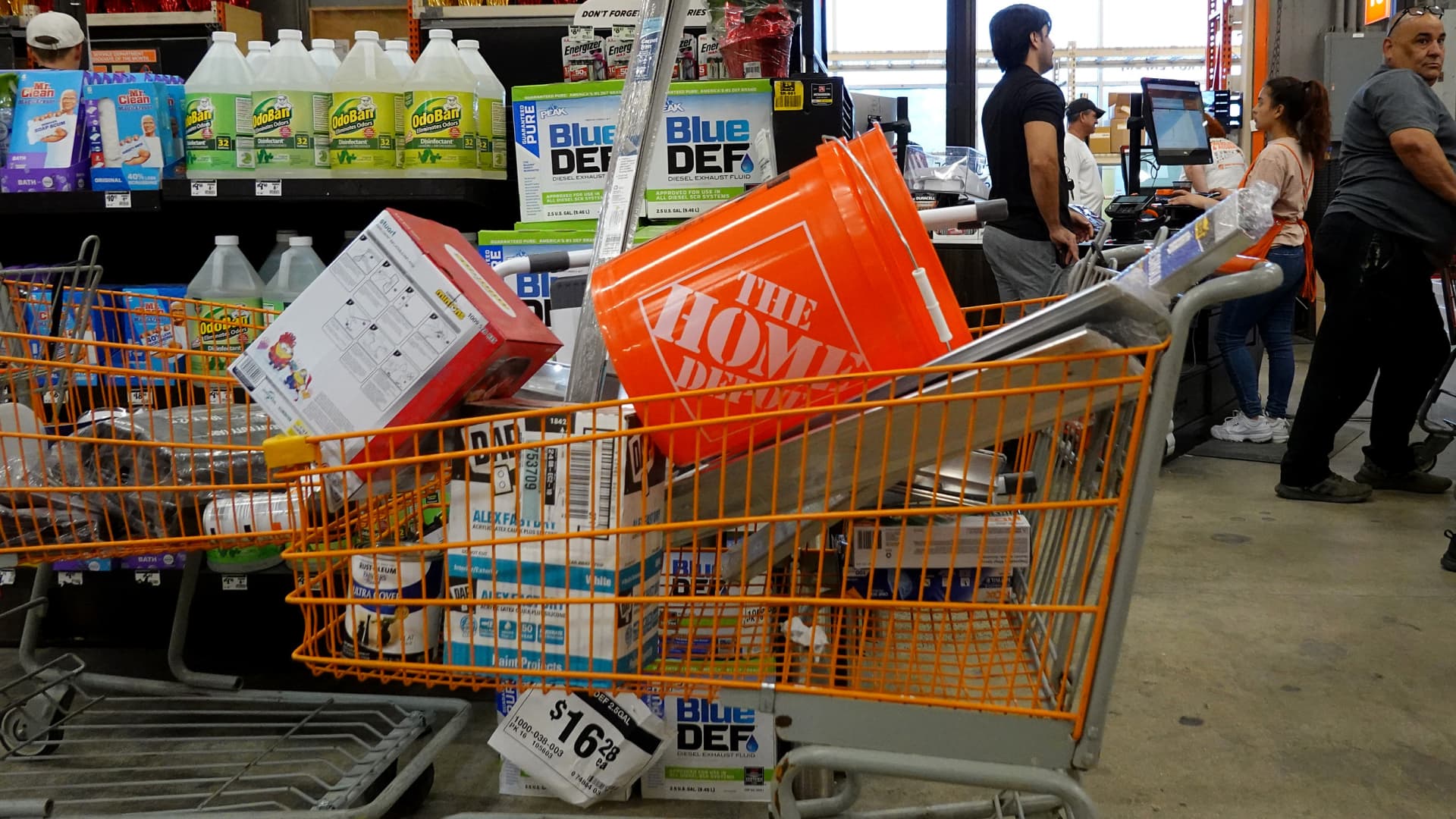Home Depot on Tuesday reported better-than-expected fourth-quarter results, but high interest rates continue to cloud its outlook for the year. Net sales in the three months ended Feb. 2 rose 14.1% to $39.7 billion, topping estimates of $39.16 billion, according to LSEG. Earnings per share (EPS) increased 6.7% on annual basis to $3.02, a penny ahead of the LSEG consensus. Same-store sales rose 0.8% in the quarter, ending a streak of eight straight quarterly declines. Analysts on average were expecting a decline between 1.5% to 2%, depending on the financial data provider. Bottom line Home Depot delivered a solid report for the November-to-January period — punctuated by the positive same-store sales growth — and provided sensible 2025 guidance considering the interest rate environment has not cooperated since the Federal Reserve’s easing campaign began in September. The Fed’s rate-cutting cycle was expected to lead to lower mortgage rates and help revive activity in the stagnant housing market, which is good for Home Depot’s business as people take up projects associated with moving. That thesis has not yet played out, as U.S. government bond yields — which influence mortgage rates — marched higher against the Fed’s grain. Accordingly, the 30-year fixed rate mortgage in the U.S. went from about 6.15% on the day of the Fed’s first rate cut to over 7% for much of the fall. The interest rate picture also has hurt the kind of larger home improvement projects that rely on financing, such as kitchen and bathroom remodeling. That dynamic remained on display in Home Depot’s fourth quarter, executives said on Tuesday’s earnings call. Home Depot Why we own it: We added Home Depot to the portfolio ahead of the Federal Reserve’s first interest rate cut in September, betting that lowering borrowing costs will be on the horizon and spark a recovery in activity in the housing market. While mortgage rates have remained stubbornly high, rebuilding efforts tied to extreme weather in the U.S. should help support the business until the housing rebound materializes. Competitors : Lowe’s Portfolio weighting: 3.18% Most recent buy: Feb. 4, 2025 Initiated : Sept. 9, 2024 Against that stubborn backdrop, Home Depot executives assumed in their guidance no improvements in rates and housing turnover, along with continued pressure on big remodeling projects. Those assumptions help explain why Home Depot’s fiscal 2025 same-store sales outlook calls for just 1% growth, lighter than the 1.7% consensus, according to FactSet. Could that prove conservative? It’s hard to say for sure, but it’s certainly possibly. We’ve seen the 10-year Treasury yield come down to under 4.3% on Tuesday after briefly topping 4.8% in mid-January, and mortgage rates have moderated alongside it, sitting at roughly 6.9%. The housing market could be a coiled spring if mortgage rates fall below 6.5%, a key level that CEO Ted Decker has previously called out . HD 1Y mountain Home Depot’s stock performance over the past 12 months. Shares of Home Depot more than 3% Tuesday, to roughly $395 a share, as the stock looks to end a six-day losing skid. It fell 7.3% during that stretch, falling into negative territory on a year-to-date basis after a solid few weeks to start 2025. Through Monday, Home Depot sat 11.4% below its all-time closing high of $431.37 set on Dec. 6. The recent stock weakness likely lowered the bar for Home Depot’s guidance, laying the groundwork for rally we’re seeing in shares Tuesday. We’re reiterating our buy-equivalent 1 rating and price target of $440 a share. Quarterly commentary Investors hold Home Depot’s management team in high regard, and as well as they may operate the company, some things are out of its control. Just like fellow Club holding Coterra Energy cannot set the price of oil, Home Depot cannot force the Fed to cut rates, helpful as that may be to bringing down mortgage rates. However, some of the softer economic data in recent days, including a weaker consumer confidence survey released Tuesday morning, could change the Fed’s calculus on rate cuts and lead to more than the market was expecting just a few weeks ago. Home equity lines of credit, known as HELOC loans, are sensitive to the Fed’s benchmark interest rate and are big sources of financing for remodeling. “The 10-year is at 4.3%. You can’t stay as negative,” Jim Cramer said. “The Fed is going to have to cut. Why? Because we’ve had a peak in employment” and inflationary pressures are concentrated in areas such as insurance and eggs, he said. Jim added, “What drives Home Depot, not just mortgage rates, is HELOC.” Indeed, Decker said on Tuesday’s earnings call that consumers tapping the value of their home to complete projects is something to watch going forward. In addition to HELOCs, a cash-out refinance mortgage is another method of doing so. Here’s what Decker had to say: “Our customer is very healthy. … But we’re not anticipating a large decrease in mortgage rates. It will be more issue of consumers getting used to these higher rates. And to take on a larger project, it’s usually financed. And that financing is through HELOCs. And we’ve started to see a little increase in each of cash-out [refinancing], as well as draws on HELOCs. But there’s literally trillions of dollars of equity built up in the U.S. housing. And as homes continue to age and people are staying in those homes and realize that we’re highly unlikely to see the low interest rates we saw over the past two, three years, that they’ll eventually tap that equity and do the larger remodeling projects. We’re just not sure that turn comes in 2025 at a dramatically accelerated pace.” In general, Home Depot has upped its pace of investments into the business as a percentage of overall sales, betting that any near-term margin pressures will be worth it for long-term growth. Serving professional customers is one of the most important parts of Home Depot’s overall growth strategy, which was on display with its $18.25 billion acquisition of SRS Distribution completed in June. Pro sales were stronger than do-it-yourself customers in the period, with strength in pro-focused categories such as gypsum, decking, concrete and sensing, according to Billy Bastek, the company’s executive vice president of merchandizing. As for SRS, specifically, executives said they remain focused on cross-selling opportunities between the two companies. Texas-based SRS, which serves professionals in the pool, roofing and landscaping markets, has opened 20 new locations of its own since June. “SRS will grow faster than the core and we believe they’re taking share in each of their three verticals. So, we’re very pleased with what SRS is doing,” Decker said. Weather is always a variable for Home Depot’s business — both good and bad. For example, in the third quarter reported in November, executives noted how nice weather throughout much of the quarter was a positive tailwind: more time for DIYers to garden and less disruptions on the job for pro customers. The picture was more mixed in the fourth quarter and for 2025. Home Depot said its same-store sales growth of 0.8% benefited from roughly $220 million in hurricane-related sales, equal 0.65 percentage points of the growth. At the same time, “horrible” weather in January across the U.S. had a negative impact on performance in that month, CFO Richard McPhail said. While executives expressed sympathy for those who were impacted by the wildfires in Los Angeles, they did not discuss the financial implications of rebuilding efforts in the area that may occur this year. Guidance Home Depot provided the following guidance for its fiscal 2025: Total sales growth of about 2.8%, generally in line with estimates. Same-store sales growth of 1%, below the 1.7% FactSet consensus. Adjusted earnings per share to fall about 2% from $15.24 in fiscal 2024, compared with a modest increase expected by analysts. Gross margin of approximately 33.4%, matching estimates. Adjusted operating margin of roughly 13.4%, below the 13.7% FactSet consensus. (Jim Cramer’s Charitable Trust is long HD. See here for a full list of the stocks.) As a subscriber to the CNBC Investing Club with Jim Cramer, you will receive a trade alert before Jim makes a trade. Jim waits 45 minutes after sending a trade alert before buying or selling a stock in his charitable trust’s portfolio. If Jim has talked about a stock on CNBC TV, he waits 72 hours after issuing the trade alert before executing the trade. THE ABOVE INVESTING CLUB INFORMATION IS SUBJECT TO OUR TERMS AND CONDITIONS AND PRIVACY POLICY , TOGETHER WITH OUR DISCLAIMER . NO FIDUCIARY OBLIGATION OR DUTY EXISTS, OR IS CREATED, BY VIRTUE OF YOUR RECEIPT OF ANY INFORMATION PROVIDED IN CONNECTION WITH THE INVESTING CLUB. NO SPECIFIC OUTCOME OR PROFIT IS GUARANTEED.
A cart full of items at a Home Depot store on November 14, 2023 in Miami, Florida.
Jon Cherry | Bloomberg | Getty Images
Home Depot on Tuesday reported better-than-expected fourth-quarter results, but high interest rates continue to cloud its outlook for the year.





